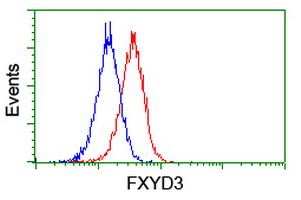FXYD3 (10V6) Mouse Monoclonal antibody
FXYD3 (10V6) Mouse Monoclonal antibody
- SPECIFICATION
- CITATIONS
- PROTOCOLS
- BACKGROUND

Application
| WB, IF |
|---|---|
| Primary Accession | Q14802 |
| Reactivity | Human |
| Clonality | Monoclonal |
| Calculated MW | 9263 Da |
| Gene ID | 5349 |
|---|---|
| Other Names | FXYD domain-containing ion transport regulator 3, Chloride conductance inducer protein Mat-8, Mammary tumor 8 kDa protein, Phospholemman-like, Sodium/potassium-transporting ATPase subunit FXYD3, FXYD3, MAT8, PLML |
| Dilution | WB~~1:1000 IF~~1:50~200 |
| Storage Conditions | -20℃ |
| Name | FXYD3 |
|---|---|
| Synonyms | MAT8, PLML |
| Function | Associates with and regulates the activity of the sodium/potassium-transporting ATPase (NKA) which transports Na(+) out of the cell and K(+) into the cell (PubMed:17077088). Reduces glutathionylation of the NKA beta-1 subunit ATP1B1, thus reversing glutathionylation-mediated inhibition of ATP1B1 (PubMed:21454534). Induces a hyperpolarization-activated chloride current when expressed in Xenopus oocytes (PubMed:7836447). |
| Cellular Location | Cell membrane; Single-pass type I membrane protein |
| Tissue Location | Isoform 1: Expressed mainly in differentiated cells (at protein level). Isoform 2: Expressed mainly in undifferentiated cells (at protein level). |

Thousands of laboratories across the world have published research that depended on the performance of antibodies from Abcepta to advance their research. Check out links to articles that cite our products in major peer-reviewed journals, organized by research category.
info@abcepta.com, and receive a free "I Love Antibodies" mug.
Provided below are standard protocols that you may find useful for product applications.
Background
This gene belongs to a small family of FXYD-domain containing regulators of Na+/K+ ATPases which share a 35-amino acid signature sequence domain, beginning with the sequence PFXYD, and containing 7 invariant and 6 highly conserved amino acids. This gene encodes a cell membrane protein that may regulate the function of ion-pumps and ion-channels. This gene may also play a role in tumor progression. Alternative splicing results in multiple transcript variants encoding distinct isoforms.
If you have used an Abcepta product and would like to share how it has performed, please click on the "Submit Review" button and provide the requested information. Our staff will examine and post your review and contact you if needed.
If you have any additional inquiries please email technical services at tech@abcepta.com.













 Foundational characteristics of cancer include proliferation, angiogenesis, migration, evasion of apoptosis, and cellular immortality. Find key markers for these cellular processes and antibodies to detect them.
Foundational characteristics of cancer include proliferation, angiogenesis, migration, evasion of apoptosis, and cellular immortality. Find key markers for these cellular processes and antibodies to detect them. The SUMOplot™ Analysis Program predicts and scores sumoylation sites in your protein. SUMOylation is a post-translational modification involved in various cellular processes, such as nuclear-cytosolic transport, transcriptional regulation, apoptosis, protein stability, response to stress, and progression through the cell cycle.
The SUMOplot™ Analysis Program predicts and scores sumoylation sites in your protein. SUMOylation is a post-translational modification involved in various cellular processes, such as nuclear-cytosolic transport, transcriptional regulation, apoptosis, protein stability, response to stress, and progression through the cell cycle. The Autophagy Receptor Motif Plotter predicts and scores autophagy receptor binding sites in your protein. Identifying proteins connected to this pathway is critical to understanding the role of autophagy in physiological as well as pathological processes such as development, differentiation, neurodegenerative diseases, stress, infection, and cancer.
The Autophagy Receptor Motif Plotter predicts and scores autophagy receptor binding sites in your protein. Identifying proteins connected to this pathway is critical to understanding the role of autophagy in physiological as well as pathological processes such as development, differentiation, neurodegenerative diseases, stress, infection, and cancer.





